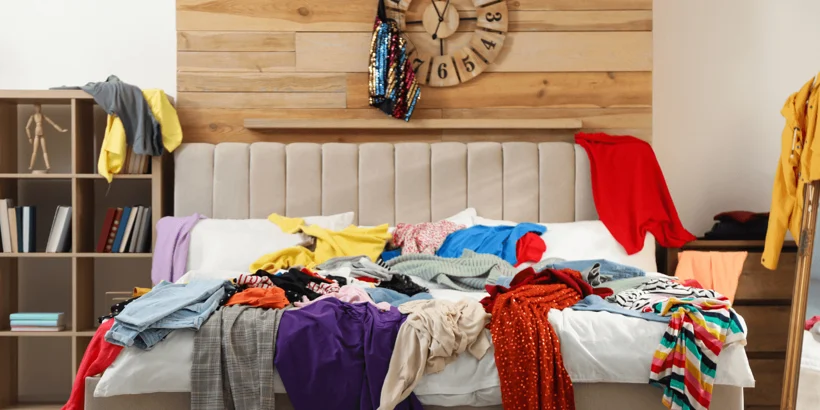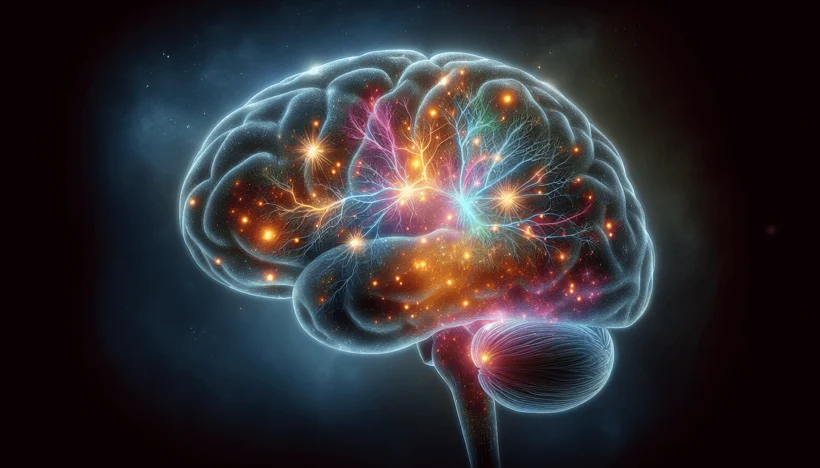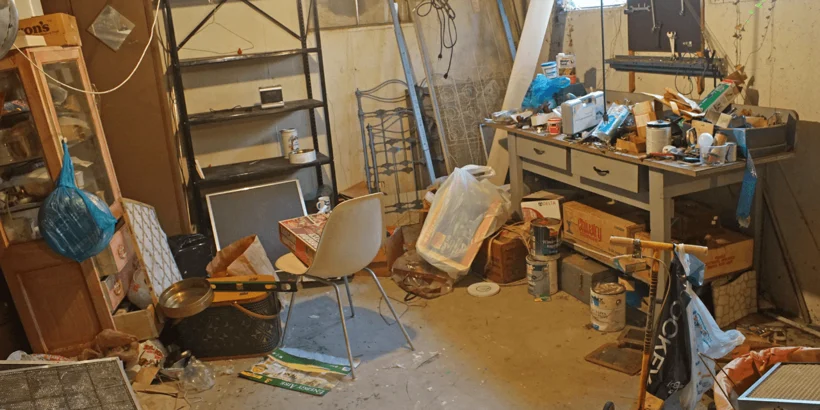
Understanding Hoarding Disorder: Causes, Impacts, and Interventions
Hoarding isn’t about laziness—it’s about safety. When stress or trauma trains the brain to over-protect, letting go can feel risky. This guide explains what’s happening in your brain and emotions, and offers trauma-informed, step-by-step ways to create safety, get the right kind of help, and make progress that lasts.
Dealing with hoarding disorder can feel like an uphill battle, can't it?
But here's the good news: understanding what you're up against is half the battle won. And that's exactly why we've put together this friendly guide. We'll take a no-nonsense look at hoarding disorder, how it can throw a spanner in the works of your everyday routine, and – most importantly – share some real, actionable tips to help you tackle this head-on.
So, if you're ready to make some positive changes and find strategies that actually work, you're in the right place!
Key Takeaways
Hoarding disorder? It's like having a really tough time letting go of stuff. Imagine feeling super attached to your possessions, to the point where it starts to really weigh on you and messes with your day-to-day groove. Getting a handle on it often means teaming up with some awesome professionals. Plus, you've got support groups and a whole community of peers who totally get what you're going through. It's all about finding the right mix of help and understanding to start turning things around.
Did you know that our brain plays a big role in hoarding behaviors? It's kind of fascinating – neurology studies show that hoarding can be linked to some quirky stuff happening in the brain areas that help us make decisions. And here's the twist: if someone's gone through tough, traumatic events, it can crank up these hoarding tendencies. It's like those experiences throw a wrench in the brain's decision-making gears and other important skills. It's all about understanding how our mind works and how life's rollercoaster moments can affect us in unexpected ways.
Tackling hoarding disorder with a holistic approach is like giving your life a full-on makeover, both inside and out. It's not just about sorting through the physical mountains of stuff; it's also about diving into the emotional and mental sides of why we hold onto things. Imagine using cool techniques like mindfulness to stay present, emotional processing to work through the feels, getting some pro tips from organizing wizards, and leaning on a network of supportive folks who've got your back.
Table of Contents
This post covers the following topics:
When Letting Go Feels Impossible: What You’re Really Up Against
Empathy and Informed Support in Dealing with Hoarding Disorder
When Letting Go Feels Impossible: What You’re Really Up Against
Hoarding disorder is like being stuck in a loop where letting go of things, no matter how little they're worth, feels almost impossible. when someone lives with hoarding disorder, people with hoarding disorder may struggle with the following symptoms:
significant distress when faced with the prospect of getting rid of items
feeling overwhelmed by the volume of their possessions, which can lead to anxiety
avoidance of tasks necessary to maintain a safe and functional living environment
Insights from neuroscience reveal that hoarding behaviors are linked to deficiencies in several areas of information processing, including planning, problem-solving, and organization. Stressful life events, particularly those related to loss and deprivation, can significantly impact hoarding behaviors.
The treatment of hoarding disorder primarily involves cognitive-behavioral therapy (CBT), with hoarding disorder treated through support accessible via various channels such as therapists, support groups, and peer networks.
What is Hoarding Disorder and Why Does It Happen?

According to the American Psychiatric Association, hoarding disorder has some pretty specific traits. It's not just about having a lot of stuff; it's about the struggle to let anything go, even if it's not particularly useful or valuable. Here's the rundown:
Trouble Saying Goodbye to Possessions: It's like everything has a 'do not discard' tag. Even things that others might easily throw away seem impossible to part with.
Feeling the Need to Save Items: People with hoarding disorder often feel they need to keep things, thinking they might be useful or valuable someday.
Believing in Future Usefulness: There's this belief that every item could come in handy at some point down the line, even if there's no immediate need for it.
Clutter Overload: The accumulation of stuff gets to a point where it really starts to affect how living spaces can be used – think less living room, more storage room.
The psychological manifestations of hoarding disorder extend beyond the physical accumulation of items. Individuals often experience stress, depression, and in some cases, co-occurring mental disorders like anxiety disorders, severe depression, schizophrenia, and obsessive-compulsive disorder (OCD). It's a complex mix of emotional and mental factors that make hoarding disorder about much more than just the physical stuff.
How the Brain Makes Letting Go So Hard

The neurobiology of hoarding disorder provides essential insights into the physiological underpinnings of this condition. Neuroimaging studies have revealed regional brain function abnormalities, particularly in the frontal and temporal brain regions, contributing to hoarding behaviors.
Delving into the brain’s role in hoarding disorder can shed light on why individuals struggle to part with their possessions, thereby laying a foundation for targeted treatment strategies.
Key Brain Areas Involved
Hoarding disorder and its connection to the brain is truly intriguing. It is associated with dysfunction of certain brain regions, such as the anterior cingulate cortex and insula. These regions play a pivotal role in decision-making processes, contributing to the individual’s struggle to part with their possessions.
The anterior cingulate cortex (ACC), for instance, exhibits abnormal function and heightened hemodynamic activity in individuals with hoarding disorder. Furthermore, individuals with hoarding disorder show hyperactivation of the insular cortex when discarding items.
These neurological insights can shed light on the challenges faced by individuals with hoarding disorder and inform effective intervention strategies.
How Trauma Disrupts Focus, Planning, and Decisions
Trauma can significantly impact the executive functioning skills of individuals, resulting in challenges with:
initiation
organization
problem-solving
impulsivity
Traumatic and stressful life events can modify neurological functions, thereby establishing a correlation between cumulative trauma exposure and heightened tendencies for hoarding behaviors. Grasping the impact of these stressful life event occurrences and understanding the risk factors is essential for effectively addressing the root causes of hoarding behaviors.
The alteration in adrenal gland function due to trauma can disrupt cortisol production, leading to elevated cortisol levels. This hormonal change may play a role in the development of hoarding behaviors. This highlights the need to consider the impact of trauma when developing therapeutic interventions for hoarding disorder.
The 5 Levels of Clutter (And Why They Sneak Up on Us)

The progressive nature of hoarding disorder can be classified into five stages, ranging from minimal to extreme clutter. Each stage is characterized by specific behaviors and indicators that can help understand the severity of the condition.
At the initial stages, individuals may show light clutter with few indicators of hoarding. As the disorder progresses, there is an increase in the accumulation of items, leading to deteriorating hygiene and extreme disorganization. The final stages involve excessive clutter, stockpiling, and severe symptoms such as intense odors and overwhelming stockpiles.
It’s important to note that hoarding disorder is not just about the physical clutter. The disorder also impacts an individual’s daily routines and behaviors, emotional well-being, and relationships with friends and family. Recognizing these stages can aid in early detection and intervention, thereby enhancing outcomes for those affected.
Beyond the Piles: Emotions, Beliefs, and Meaning
Hoarding is more than an accumulation of items; it is deeply rooted in emotional and mental aspects. The psychological manifestations linked to hoarding disorder include persistent challenges in discarding possessions, intense urges to save items, and notable distress or impairment in functioning. These psychological perspectives are crucial in understanding the multi-faceted nature of hoarding disorder.
Traumatic experiences, particularly those related to loss and deprivation, can significantly impact hoarding behaviors. Traumatic experiences can have a profound effect on an individual’s mental health, leading to unresolved emotional issues and the development of hoarding tendencies.
Comprehending these psychological perspectives is key to addressing the underlying causes of hoarding behaviors and furnishing effective treatment. Interventions for hoarding disorder should therefore focus not just on the physical decluttering but also on addressing these underlying emotional aspects.
Getting to the Roots (So Change Actually Sticks)
Identifying and tackling the root causes of hoarding behavior, including hoarding animals and hoard animals, is critical in managing and treating hoarding disorder.
Emotional triggers and coping mechanisms play a significant role in hoarding disorder, which often necessitates a comprehensive approach to treatment.
Common Emotional Triggers (Loss, Fear, Uncertainty)
Emotional triggers such as stressful life events and emotional attachments to objects can significantly contribute to hoarding behavior. These triggers may evoke strong emotional reactions and lead individuals to cope with their emotions or distract themselves from negative feelings by accumulating possessions.
Grief and loss can also trigger hoarding behavior. Individuals may use objects to cope with their grief, attaching emotionally to possessions as a way to maintain control and security. Tackling these emotional triggers is important for effective management of hoarding behaviors.
Coping Strategies That Help vs. Hurt
Individuals suffering from hoarding disorder might adopt various coping mechanisms to deal with their emotions or as a response to trauma. These coping strategies may involve cognitive distortions and resorting to hoarding as a distraction from negative feelings.
Effective coping mechanisms for hoarding disorder involve cognitive behavioral therapy (CBT), acceptance and mindfulness-based methods, and creating a safe and non-judgmental environment. These approaches can assist individuals in coping with the challenging emotions associated with their triggers and decrease their compulsion to hoard.
Who Can Help—And How to Ask Safely
Professional help and support networks play a vital role in helping individuals manage and overcome hoarding disorder. Mental health professionals, professional organizers, and support networks can provide valuable guidance and support, facilitating recovery.
Therapists & Evidence-Based Care (CBT and More)
Mental health professionals predominantly utilize cognitive-behavioral therapy (CBT) to address hoarding disorder, with a focus on identifying and challenging thoughts and beliefs about hoarding to help manage the behavior.
Cognitive-behavioral therapy offers support for individuals with hoarding disorder by addressing the underlying thoughts and behaviors associated with hoarding, and by altering detrimental acquisition and saving habits. By working closely with a mental health professional, individuals with hoarding disorder can gain a better understanding of their condition, develop effective coping strategies, and make significant strides towards recovery.
Compassionate Organizing Help (No Shame, No Surprises)
Professional organizers play a vital role in addressing hoarding disorder by offering essential support and guidance in decluttering, organizing, and establishing effective systems for managing possessions.
Professional organizers offer practical organizing strategies and support, which can aid individuals with hoarding disorder in decluttering and creating functional living spaces. They aid individuals in making decisions regarding items to donate, discard, keep, or sell, and utilize strategies such as room-by-room guides to maintain a decluttered and clean space.
Support Groups, Peers, and Family Roles
Support networks are essential for providing emotional support and practical assistance for individuals with hoarding disorder. They provide:
Emotional support
Understanding
Encouragement
Practical assistance
These elements are crucial in an individual’s progress in overcoming hoarding behavior.
Support networks, particularly support groups, have shown substantial reduction in clutter, difficulty discarding, and excessive acquisition. By providing a safe and supportive environment, support networks can help individuals with hoarding disorder improve their coping strategies and achieve lasting changes.
Trauma-Informed Decluttering: A Whole-Person Approach

Holistic decluttering strategies incorporate both physical and emotional aspects to help individuals with hoarding disorder manage their condition. This approach recognizes that addressing the physical clutter alone is insufficient for lasting change. Rather, it requires a comprehensive approach that addresses the emotional and psychological aspects of hoarding as well.
Mindfulness You Can Use Mid-Declutter
Mindfulness skills play a crucial role in providing a protective buffer against stressful periods, aiding individuals with hoarding disorder in becoming more aware of their emotions, which is essential in managing compulsive hoarding behaviors.
Mindfulness techniques, such as meditation, deep breathing, and yoga, enable individuals to heighten their present-moment awareness of thoughts and emotions. This heightened awareness supports more deliberate decision-making in the context of decluttering, without becoming overwhelmed.
Feeling Your Feelings—Without Getting Flooded
Emotional processing plays a significant role in aiding individuals with hoarding disorder by facilitating their understanding and management of emotions associated with hoarding.
Effective emotional processing strategies for hoarding disorder include cognitive behavioral therapy (CBT), which helps individuals learn skills to better regulate their emotions, and the incorporation of emotion regulation strategies into treatment. By improving emotional regulation and altering cognitive patterns, individuals can develop healthier coping strategies and achieve lasting changes.
Design Your Space to Lower Stress
To assist individuals with hoarding disorder, fostering a supportive and non-confrontational living environment is of great importance. A positive environment can support the decluttering process for individuals with hoarding disorder by fostering understanding, empathy, and support, thus creating a non-judgmental space that promotes safety and motivation during the decluttering process.
A positive environment can also support the decluttering process by fostering understanding, empathy, and support. Such an environment can make a significant difference in the lives of individuals with hoarding disorder, helping to mitigate stress and anxiety, enhance the effectiveness of therapeutic interventions, and promote overall well-being.
Institute for Challenging Disorganization (Tools You Can Use)
The Institute for Challenging Disorganization (ICD) provides an approach to chronic disorganization and hoarding, focusing on understanding and addressing the root causes of hoarding behavior. In line with the diagnostic and statistical manual, the ICD offers resources and guides tailored to individuals with hoarding disorder. These include the Clutter-Hoarding Scale® as an assessment tool and the publication ‘The ICD Guide to Collaborating with Professional Organizers’ by Phyllis Flood Knerr. These tools and resources can be instrumental in helping individuals understand their hoarding behaviors and develop effective strategies to manage them.
Tiny Wins, Real Momentum
Real-life success stories demonstrate the transformative power of holistic decluttering and support in overcoming hoarding disorder. These stories highlight how individuals with hoarding disorder have been able to:
significantly improve their well-being
make substantial lifestyle changes
experience a sense of relief and freedom
create a safe and organized living environment
All of these positive outcomes were achieved through combined decluttering efforts and professional help.
Support networks significantly contribute to the success of individuals overcoming hoarding disorder by:
Providing knowledge about the disorder
Assisting with the assessment of intervention quality
Offering guidance and emotional encouragement through various forms of support groups
These stories serve as a beacon of hope, demonstrating that recovery is not only possible but achievable with the right support and resources.
If You’re Helping Someone You Love

Empathy and informed support play a critical role in helping individuals with hoarding disorder. Recognizing the challenges faced by individuals with hoarding disorder can promote a compassionate approach that encourages change and facilitates recovery.
First, Understand What Feels at Stake
Recognizing the multifaceted nature of hoarding disorder is crucial for providing effective support. Individuals with hoarding disorder experience significant distress when faced with the prospect of getting rid of items. They may also feel overwhelmed by the volume of their possessions, leading to anxiety and avoidance of tasks necessary to maintain a safe and functional living environment. This overwhelming feeling can be a sign of an underlying anxiety disorder.
In addition to the physical clutter, hoarding disorder also impacts an individual’s daily routines and behaviors, emotional well-being, and relationships with friends and family. Understanding these struggles can assist in early recognition and intervention, thereby improving outcomes for those affected.
Then, Offer Help That Feels Safe
Offering compassionate, informed help can make a significant difference in the lives of individuals struggling with hoarding disorder. Compassionate assistance involves supporting individuals during cleaning or clearing processes, researching therapists and treatment programs, and encouraging talk therapy or support groups.
By providing a safe and supportive environment, compassionate help can aid individuals with hoarding disorder in improving their coping strategies and achieving lasting changes.
The Takeaway
Overcoming hoarding disorder is challenging but possible with understanding, empathy, and support from professionals and loved ones. The journey towards a more balanced and fulfilling life is achievable for those affected by hoarding disorder.
Understanding the multifaceted nature of hoarding disorder, offering informed support, and fostering a compassionate environment can significantly benefit individuals struggling with hoarding disorder. With patience, understanding, and the right interventions, individuals with hoarding disorder can embark on a transformative journey towards a more balanced and fulfilling life.
In conclusion, hoarding disorder is a complex mental health condition characterized by persistent difficulty discarding or parting with possessions. It is deeply rooted in both neurological and psychological aspects, making it a challenging disorder to manage and treat. However, with understanding, compassion, and informed support, individuals struggling with hoarding disorder can embark on a transformative journey towards recovery.
Effective intervention strategies for hoarding disorder include cognitive-behavioral therapy, professional organizing, and support networks. Holistic decluttering strategies that incorporate mindfulness techniques, emotional processing, and creating a positive environment can significantly aid in managing the disorder. The Institute for Challenging Disorganization (ICD) provides valuable resources and guides that can help individuals understand their hoarding behaviors and develop effective strategies to manage them.
Understanding the multifaceted nature of hoarding disorder, addressing the root causes, and offering compassionate, informed support can make a significant difference in the lives of individuals struggling with hoarding disorder. With the right support and resources, recovery is not only possible but achievable, enabling individuals to lead more balanced and fulfilling lives.
Frequently Asked Questions
What are early signs of hoarding disorder?
Difficulty discarding items, excessive clutter, and anxiety when trying to let go are early indicators.
Is hoarding connected to trauma?
Yes — when people experience loss or pain, objects can become symbols of safety. Understanding this helps approach decluttering with empathy, not judgment.
How can family members support someone who hoards?
Offer empathy, avoid judgment, and encourage small, safe steps—professional coaching can help create structure.
What are 3 symptoms of hoarding disorder?
Hoarding disorder can be diagnosed through symptoms such as difficulty discarding items, excessive accumulation of possessions, and living spaces becoming unusable. If you notice these symptoms in yourself or someone else, it's important to seek professional help for a proper diagnosis and treatment.
Is hoarding an anxiety disorder?
Yes, hoarding disorder is classified as part of the obsessive-compulsive disorder spectrum, which is an anxiety disorder, but hoarding disorder itself is a distinct condition.
What is the root cause of hoarding?
The root cause of hoarding can be a combination of altered brain connections, genetics, stress, OCD, environmental factors, altered levels of serotonin, deficits in decision making, inattentiveness, and a lack of inhibition. These factors contribute to the severe psychological disorder of hoarding.
What is the best treatment for hoarding disorder?
The best treatment for hoarding disorder is cognitive behavioral therapy (CBT), which helps individuals understand the underlying reasons behind their difficulty discarding items and provides practical tasks to address the clutter. Both individual and group CBT have been shown to be effective in this regard.
What are the neurobiological symptoms of trauma?
The neurobiological symptoms of trauma include hyperarousal, startle responses, sleep disturbances, and difficulty reading social cues due to the limbic system being stuck on "high alert." This can lead to PTSD symptoms such as intrusive thoughts and flashbacks.




